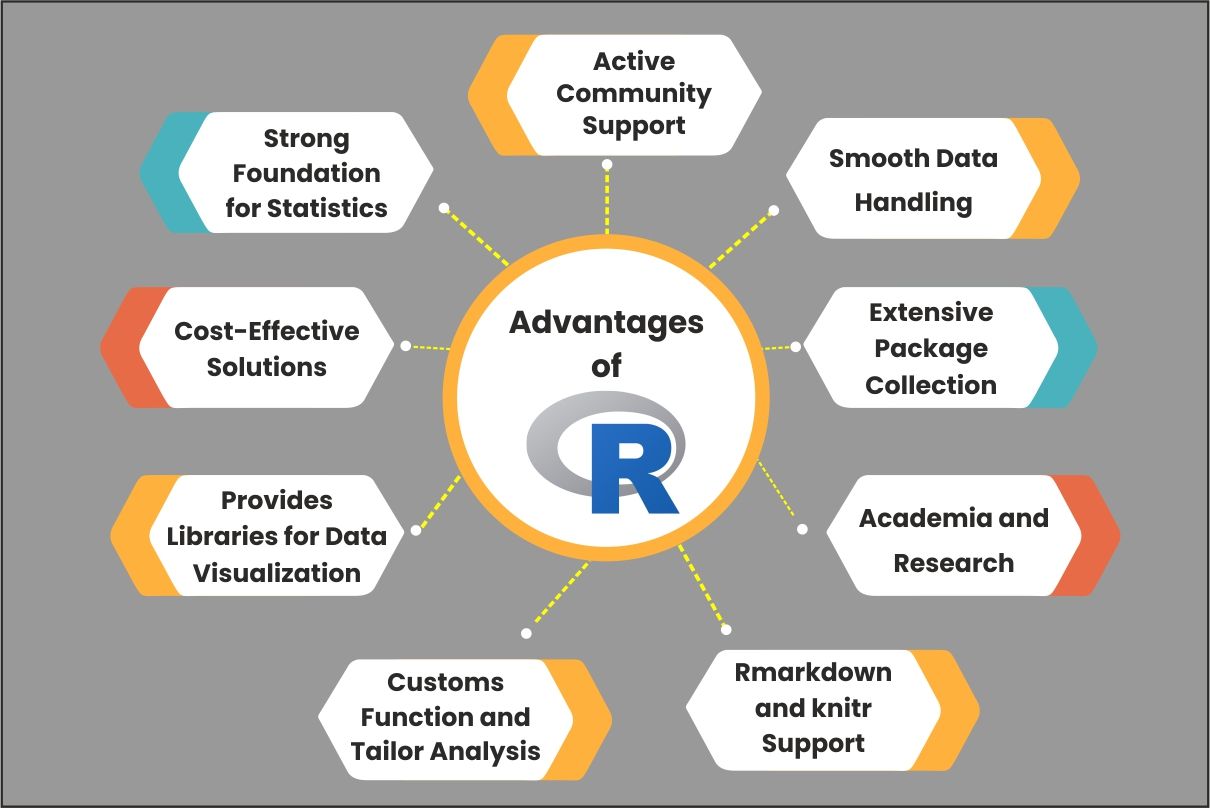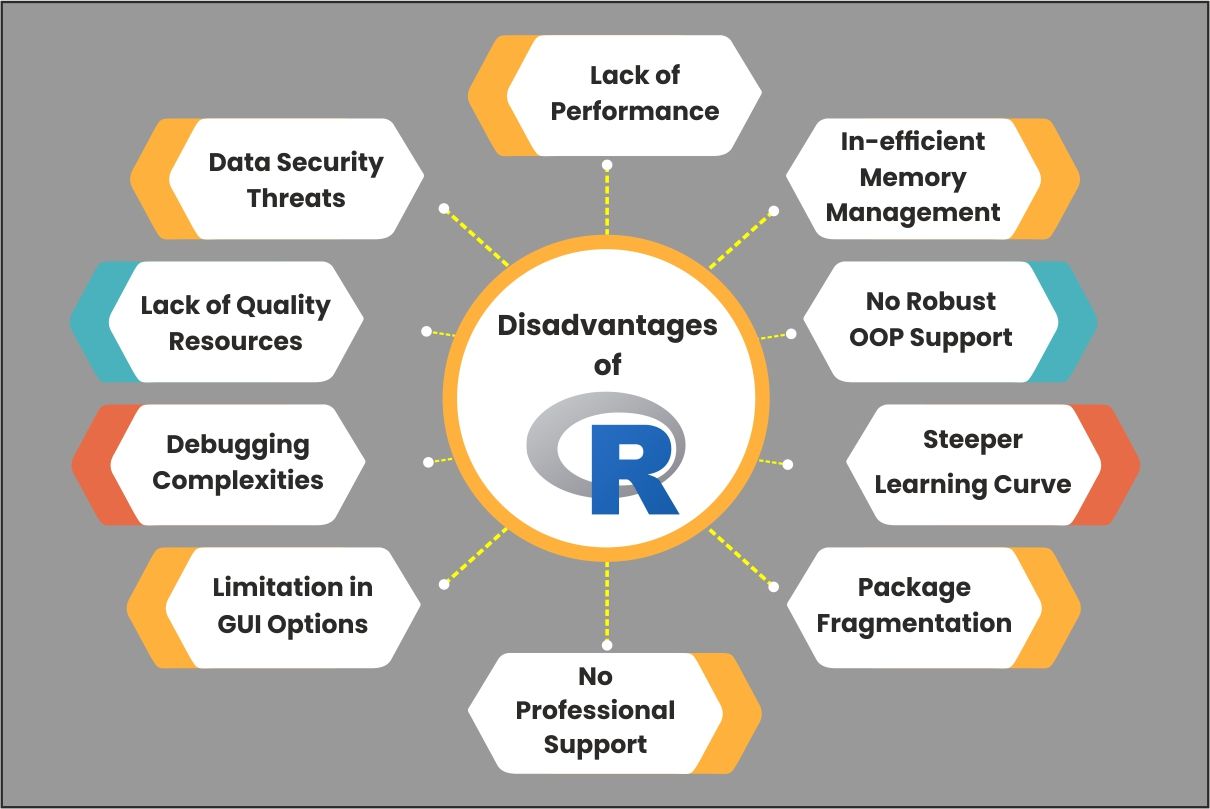Table of Contents
ToggleIntroduction
R has grown in popularity with the advent of data science. R is widely used in the fields of data science, academic research, and statistics. R’s data visualization capabilities with packages such as ggplot2 make it easy to create charts and graphs. In a recent TIOBE Index survey, R held the 17th position among all the bigwigs like Python, PHP, C#, and more. Great for a newbie? Isn’t it? Yes! So, today we will see how R rose to popularity. What are its advantages and disadvantages, and more.
Must Read- WHAT IS R PROGRAMMING? WHAT IS R USED FOR?
What Are the Advantages of R?

- Active Community Support: R has an enthusiastic community of developers, researchers, and users from around the globe that fosters the approach of collaboration, knowledge sharing, and developing new packages continuously.
- Smooth Data Handling: Importing, cleaning, and manipulating data is easy with R. Users can smoothly handle real-world datasets that require pre-processing and transformation.
- Extensive Package Collection: Rich package ecosystems are available on Bioconductor, GitHub, and CRAN, which is sufficient to handle a wide range of data analysis and statistical tasks. On top of that, it provides ready-to-use functions and tools to implement complex algorithms in time time-efficient manner.
- Academia and Research: R is best suited for academic and research use; it allows researchers to perform advanced data analysis to publish it.
- RMarkdown and knitr Support: It allows reproducible research by combining data, code, and analysis results in a single document.
- Customs Function and Tailor Analysis: R’s extensibility and flexible nature let users customize functions as per their specific needs. Additionally, users can also connect R with different programming languages such as C, Python, and Java.
- Provides Libraries for Data Visualization: It provides libraries like ggplot2 that give the flexibility to create various impressive data visualizations such as publication-quality plots, charts, and graphs. Therefore, it helps businesses and organizations to communicate insights through this data effectively.
- Cost-Effective Solutions: R is free to use and redistributable, which makes it an excellent choice for organizations and individuals to leverage data analysis capabilities at a low cost.
- Strong Foundation for Statistics: R is a powerful tool to conduct linear and nonlinear modeling, time series analysis, and hypothesis testing for Statistical analysis. Users can use its built-in functions and libraries to perform complex statistical tasks.

Don't miss out on your chance to work with the best
apply for top global job opportunities today!
What Are the Disadvantages of R?

- Lack of Performance: R is not the best option for high-performance computing tasks due to its interpreted nature. Therefore, handling large datasets and complex calculations using R would be complex.
- In-efficient Memory Management: It is highly likely for users of R to encounter memory allocation errors and slow performance issues.
- No Robust OOP Support: R does not provide robust support for Object-Oriented Programming which may cause restrictions on many software designs and programming structures.
- Steeper Learning Curve: Its wide collection of packages and unconventional syntax can make it challenging for novices to grasp the concept of R. To get expertise in R requires extra time and effort, especially for beginners.
- Package Fragmentation: R offers an array of packages, which can lead to overlapping functionalities. Sometimes it is not well maintained and potentially causes compatible issues.
- No Professional Support: R is a free source, which means there is no official commercial support, especially for organizations that rely on R may face challenges in getting professional support.
- Limitation in GUI Options: Even though R provides GUIs such as RStudio and R Commander, users may still find them less comprehensive than other data analysis tools.
- Debugging Complexities: We cannot rely on the R’s error message as it doesn’t provide clear guidance. Thus, identifying the root cause and debugging will be challenging for amateurs.
- Lack of Quality Resources: With a wide range of learning resources, R fails to provide accurate documentation and tutorials. Sometimes users may get confused with the provided information.
- Data Security Threats: As R is an open-source language, many raise security concerns while dealing with sensitive data in commercial or private ecosystems.
Final Words
R programming is an advantageous and reliable tool for conducting data analysis and statistical tasks. It provides a wide range of package ecosystems, visualization tools, and statistical capabilities to get valuable insights from complex datasets. Despite its drawbacks, its advantages make it the best language to explore and extract meaningful insights. If you want to build a career in data science, then sign up with Olibr now!
FAQs
R lacks the support of 3D graphics because of its origin from the older programming language S. Therefore, R cannot produce interactive 3D visualizations for machine learning applications.
Most programming languages has basic security which is a must to embed any language in the web application. However, R has many restrictions due to which it cannot embedded.
Yes, R is a bit challenging as it is slightly different than coding. But that being said, it’s nothing impossible, you can learn it by putting in extra effort. Before you start with R, it is recommended to have a basic knowledge of graphs and statistics, that way it is much easier to learn.
Take control of your career and land your dream job
sign up with us now and start applying for the best opportunities!


